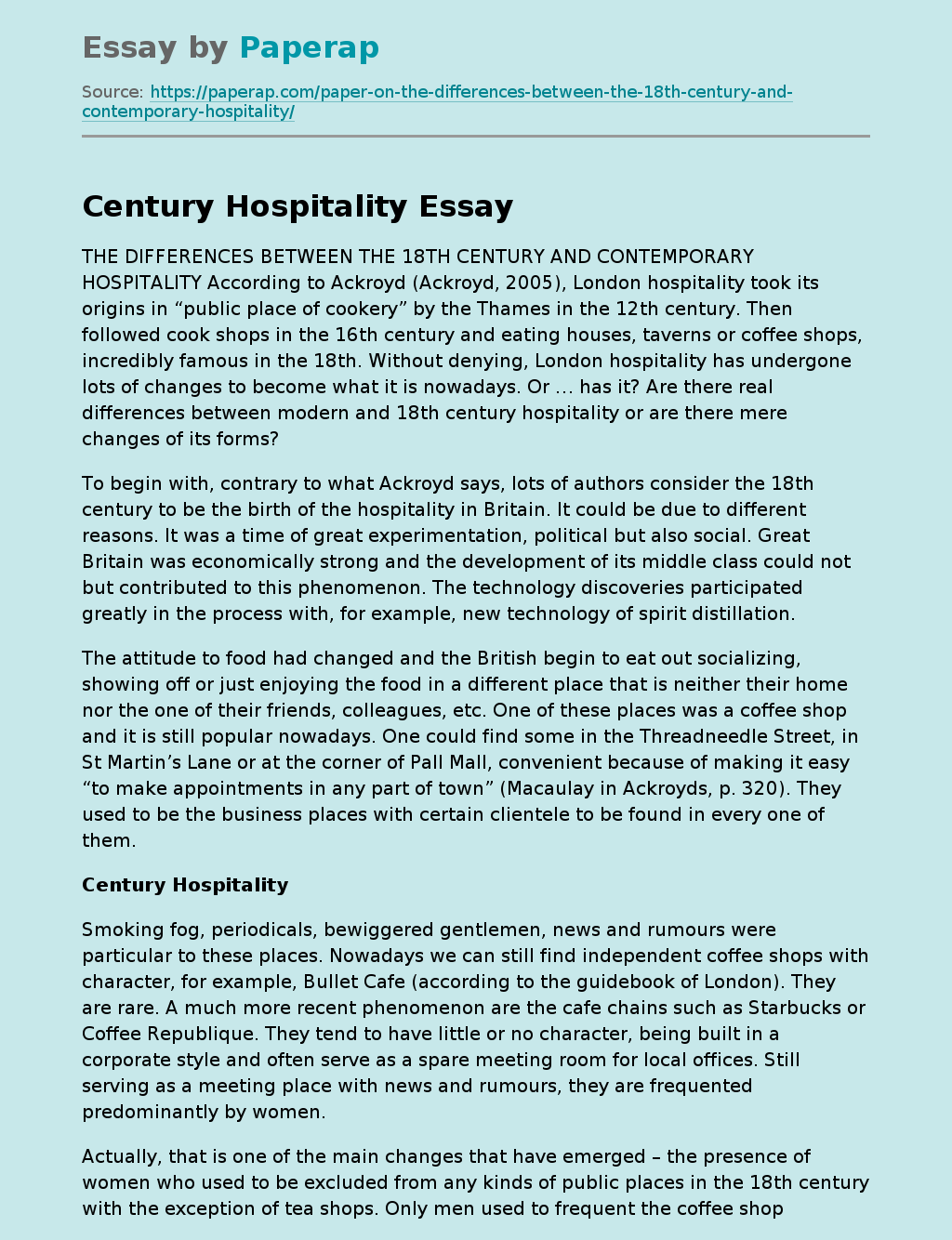The following sample essay on “Century Hospitality”: the differences between the 18th century and contemporary hospital.
According to Ackroyd (Ackroyd, 2005), London hospitality took its origins in “public place of cookery” by the Thames in the 12th century. Then followed cook shops in the 16th century and eating houses, taverns or coffee shops, incredibly famous in the 18th. Without denying, London hospitality has undergone lots of changes to become what it is nowadays. Or … has it? Are there real differences between modern and 18th century hospitality or are there mere changes of its forms?
To begin with, contrary to what Ackroyd says, lots of authors consider the 18th century to be the birth of the hospitality in Britain.
It could be due to different reasons. It was a time of great experimentation, political but also social. Great Britain was economically strong and the development of its middle class could not but contributed to this phenomenon. The technology discoveries participated greatly in the process with, for example, new technology of spirit distillation.
The attitude to food had changed and the British begin to eat out socializing, showing off or just enjoying the food in a different place that is neither their home nor the one of their friends, colleagues, etc. One of these places was a coffee shop and it is still popular nowadays. One could find some in the Threadneedle Street, in St Martin’s Lane or at the corner of Pall Mall, convenient because of making it easy “to make appointments in any part of town” (Macaulay in Ackroyds, p.
320). They used to be the business places with certain clientele to be found in every one of them.
Century Hospitality
Smoking fog, periodicals, bewiggered gentlemen, news and rumours were particular to these places. Nowadays we can still find independent coffee shops with character, for example, Bullet Cafe (according to the guidebook of London). They are rare. A much more recent phenomenon are the cafe chains such as Starbucks or Coffee Republique. They tend to have little or no character, being built in a corporate style and often serve as a spare meeting room for local offices. Still serving as a meeting place with news and rumours, they are frequented predominantly by women.
Actually, that is one of the main changes that have emerged – the presence of women who used to be excluded from any kinds of public places in the 18th century with the exception of tea shops. Only men used to frequent the coffee shops and only men used to eat out in eating-houses which “in the 18th century became known as beef houses or chop houses, together with taverns specializing in more formal or protracted food” (Ackroyd). The famous ones were Dolly’s Chop-house in Paternoster Row or cook-shops behind St Martin-in-the-Fields.
The common food was meat. The recipes were not sophisticated with little influence of foreign cuisines. At least they pretended to be so, as you could find elements of French cuisine, for example, in the cookery books of that time. Nowadays due to globalisation and social changes including the customers’ behavioural changes, the situation is completely different. There exist a great number of any types of restaurants in London, serving food of five continents with the ingredients of all over the world.
They are eager to satisfy the demand of any customer, looking for a traditional or exotic food, heavy or sane, “expensive” or “cheap”, fast food or haute cuisine. You can find all these different types of food in another form of hospitality that existed also in the 18th century but at that time with the food particular to that period – take away. Surprisingly, in London it seems like this niche is not dominated by the global chains like McDonalds or KFC, etc to the extent they do in other countries.
There exist lots of local independent businesses offering traditional fish and chips or Patoka or Chinese food and they constitute an important part of the take away market. We could also speak about new concepts of hospitality that didn’t exist before, like theatre cafe or restaurants with live music, clubs or degustation menus. Summarizing it up, we can agree that there exist differences between the hospitality of the 18th century London and of the modern one.
We can cite globalisation, emancipation of women, technological advances, new organisational and social models as ones of the reasons of these changes. Yet one thing probably has not changed – seeing food as a symbol of the society it belongs to and being particular to its characteristics, the reasons why people eat out and the extent they could enjoy it. The thing is that every time we are looking for something new, different, special and the hospitality just follows us.
Century Hospitality. (2019, Dec 05). Retrieved from https://paperap.com/paper-on-the-differences-between-the-18th-century-and-contemporary-hospitality/

